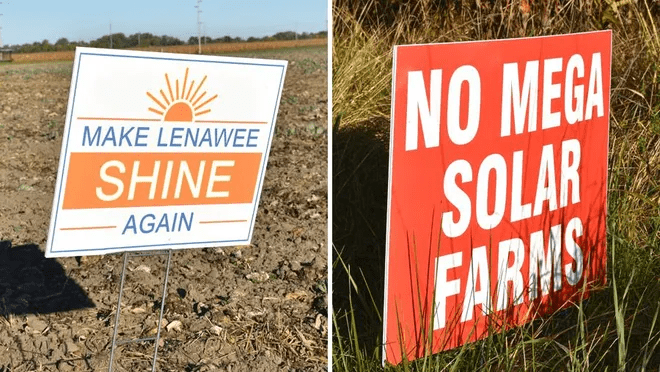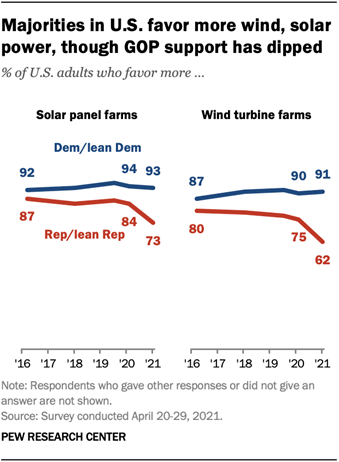The solar industry has arguably never been in a better position in the wake of the passage of the Inflation Reduction Act (IRA). A rise in NIMBY-inspired land-use policies, however, is threatening to disrupt some of that optimism.
A Worrying Trend
The passage of the IRA is a seminal moment for the solar industry that will likely spur a “gold rush” of sorts as developers seek to take advantage of the increased market certainty and race to gobble up suitable land for large solar farms. Solar farms have been around for some time, but favorable market dynamics continue to increase their prevalence. According to data from 2018 gathered by the Energy Information Administration (EIA), there are over 2,500 utility-scale solar PV developments generating electricity in the United States. More recent data from the Solar Energy Industries Association (SEIA) puts the number closer to 10,000.
As utility-scale solar farms have become more commonplace, so too have the concerted efforts to push back against them. This pushback has been led by grassroots community activists who are often adept at leveraging social media to organize opposition around solar developments. According to an April analysis by Reuters, there were:
“45 groups or pages on Facebook dedicated to opposing large solar projects, with names such as “No Solar in Our Backyards!” and “Stop Solar Farms.” Only nine existed prior to 2020, and nearly half were created in 2021. The groups together boast nearly 20,000 members.”
The ultimate goal of these grassroots activists is to influence the decision-making of local planning commission members and elected officials who are tasked with evaluating these projects. There is evidence that they are doing just that. An NBC News article from March documented the following:
“NBC News counted 57 cities, towns and counties across the country where residents have proposed solar moratoriums since the start of 2021, according to local news reports, and not every proposed ban gets local news coverage. At least 40 of those approved the measures. Other localities did so in earlier years.”
A Google search of “solar moratoriums” show plenty local solar moratoriums that have been established by municipalities across the country in just recent years.
Dispelling the Myths
The opponents of utility-scale solar projects can be quite a motley crew. On one end of the spectrum, there are climate skeptics who think climate change is a “hoax” and outright oppose renewable energy investments on the grounds that they are not needed. And then there are opponents with environmental and land conservation concerns who worry about deforestation and related ecological impacts associated with utility-scale solar developments.
The reasons cited by opponents of solar projects generally fall into two buckets; a) misinformation or b) valid concerns that are easily addressed by appropriate developer-led mitigation efforts. Here are some of the most common reasons that people oppose solar projects.
Common Myths:
- Solar panels contain hazardous materials that can leach into the soil and surrounding water systems
- Solar panels are generally comprised of materials that are abundant and commonplace like glass, aluminum, cooper, and silicon. However, it is true that some panels incorporate some heavy metals and hazardous materials like lead, arsenic, and cadmium telluride. An abundance of research shows that extremely limited amounts of the hazardous materials from solar panels leach into the environment. This academic paper from the National Library of Medicine concludes that very little cadmium escapes into the environment, even under harsh landfill conditions. Research by the International Energy Agency (IEA) likewise concluded that the risk posed by the leaching of heavy metals out of solar panels is well below U.S. regulatory thresholds.
- Solar developments have a negative impact on the property values of nearby homeowners.
- There are plenty of reports and statements – often from home appraisers – stating that there is no evidence to support the theory that solar farms negatively affect property values of nearby property owners. One of the most widely circulated independent investigations into the topic is this 2018 report by researchers at the University of Texas’ LBJ School of Public Affairs. The majority of surveyed home appraisers (66%) said it was their professional opinion that proximity to a solar installation had no impact on nearby home values, while 11% said they actually had a positive impact.
Valid Concerns & Appropriate Mitigation Response:
- Solar developments that require the removal of a large amount of mature trees and other vegetation can lead to soil erosion that can affect nearby properties.
- Solar panels are angled in such a way that a lot of rainwater hits over and over again at the “drip line.” The sheer size of utility-scale solar farms creates valid concerns over how this rainwater is dealt with. Thankfully, there are a number of mitigation tactics that can be pursued, in addition to standard industrial-grade stormwater management practices like drainage ditches and retention ponds. Incorporating native grasses and other vegetation is one of the most affordable low-hanging fruit options. The plants help to absorb water and their root systems give the soil more stability. Geotextile fabrics are also an increasingly popular method of erosion control on solar farms.
- Solar developments in rural America can occupy large amounts of farmland that have important cultural and economic importance in a community.
- Solar farms are indeed best suited for placement on agricultural land due to the general expansiveness of such property, lack of shade producing vertical obstructions, and favorable municipal regulations. A common myth is that solar panels prevent said land from ever being used for agricultural use. In fact, solar panels can be a complement to the existing agricultural use. The whole cottage industry of “agrivoltaics” has emerged to show that solar panels can coexist on property used for livestock, and both crop and honey harvesting.
- Solar panels can disrupt sightlines for nearby homeowners who otherwise prefer natural surroundings.
- Concerns by neighbors over disrupted viewsheds are among the most often cited criticisms of solar farms. A tree fence or similar landscape buffer is a common remedy to alleviate these concerns, and sometimes, an additional setback can be employed to further appease neighbors who want more action to be taken.
Finding Common Ground
The most effective solar developers are those who view community pushback not as a headache, but as an educational opportunity that can ultimately lead to pivotal long-term relationships with community stakeholders.
Solar developers who go out of their way to engage with community members – even those who oppose their project – are best positioned to achieve positive outcomes. Putting forward a good faith effort to engage with and educate community members should be a foundational aspect of any stakeholder engagement process. The unique thing about solar farms is that they have 30+ year lifespans, which really underscores the need for developers to be intentional about developing and maintain long-term relationships in the communities that they work. Many prominent solar developers provide grants or similar philanthropic donations in the communities that they work in that support community and/or economic development priorities. Partnering with the local community college around solar worker-focused training programs is another common and effective way for developers and communities to align around common priorities.
It is hard to talk about opposition to solar projects without talking about politics. Utility-scale solar projects are primarily located in rural communities that have conservative politics. Once upon a time, this fact wasn’t that noteworthy, but it is now quite relevant in an era of increased political polarization. Support by conservative voters for solar and wind farms has dropped sharply in recent years, according to the Pew Research Center. In 2020, 84% of Republicans and Republican-leaning independents supported “solar panel farms,” but this support fell to 73% by 2021. This is clearly an ominous sign since these renewable projects are often a best fit in conservative-leaning communities.
Instead of shunning these solar skeptics, the partisan divide over support for solar farms represents a great opportunity for developers to partner with organizations committed to bridging this growing partisan gap. Conservatives for Clean Energy (CCE) is one such organization with a growing presence in the Southeast. From their website, the organization “proudly educates the public and decision-makers on the economic benefits of clean energy and advocates for continued investments across the Southeast.” CCE has state-based chapters in Florida, Georgia, North Carolina, South Carolina, and Virginia. This podcast interview by the North Carolina Sustainable Energy Association (NCSEA) with CCE President/CEO, Mark Fleming, covers a lot of relevant topics about how CCE seeks to be a resource to conservative lawmakers.
The Center for Energy Education is another organization involved in educating lawmakers and the general public about the benefits of solar energy. The Center claims on their website to have educated over 730 public officials on the virtues of solar energy. The organization has provided structured training and workshops to thousands more across the country.
Advocacy organizations like these play such a critical role in breaking through misinformation and educating the public on the myriad of benefits that solar energy can bring to their community. Successful large-scale solar developments hinge on the ability to secure local support. It is critical for solar developers and local stakeholders alike to embrace the opportunity to learn from one another, and approach these projects with an open mind and collaborative spirt.
Cover Photo Source: LenConnect.com







